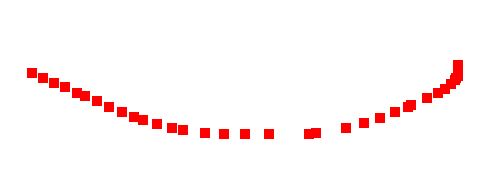
The example in this article describes the simple mouse following DiV layer effect implemented in JS. Share it with everyone for your reference, the details are as follows:
This code presents a string of Div effects that follow the mouse, and has a drag effect. As the mouse shakes rapidly, the Div layer effect will continue to increase, and the following Divs will automatically disappear. However, there are still some bugs. I look forward to working with you. Please improve this JS effect.
The screenshot of the running effect is as follows:

The online demo address is as follows:
http://demo.jb51.net/js/2015/js-simple-mouse-over-div-codes/
The specific code is as follows:
<!DOCTYPE html PUBLIC "-//W3C//DTD XHTML 1.0 Transitional//EN"
"http://www.w3.org/TR/xhtml1/DTD/xhtml1-transitional.dtd">
<html xmlns="http://www.w3.org/1999/xhtml">
<head>
<style>
div {width:10px; height:10px; background:red; position:absolute;}
</style>
<meta http-equiv="Content-Type" content="text/html; charset=utf-8" />
<title>跟随鼠标的Div效果</title>
<script>
window.onload=function ()
{
var aDiv=document.getElementsByTagName('div');
var i=0;
setInterval(function(){
for(i=aDiv.length-1;i>0;i--)
{
aDiv[i].style.left=aDiv[i-1].style.left;
aDiv[i].style.top=aDiv[i-1].style.top;
}
},5);
document.onmousemove=function (ev)
{
var oEvent=ev||event;
aDiv[0].style.left=oEvent.clientX+'px';
aDiv[0].style.top=oEvent.clientY+'px';
};
};
</script>
</head>
<body>
<div></div>
<div></div>
<div></div>
<div></div>
<div></div>
<div></div>
<div></div>
<div></div>
<div></div>
<div></div>
<div></div>
<div></div>
<div></div>
<div></div>
<div></div>
<div></div>
<div></div>
<div></div>
<div></div>
<div></div>
<div></div>
<div></div>
<div></div>
<div></div>
<div></div>
<div></div>
<div></div>
<div></div>
<div></div>
<div></div>
<div></div>
<div></div>
<div></div>
<div></div>
<div></div>
<div></div>
<div></div>
<div></div>
<div></div>
<div></div>
</body>
</html>
I hope this article will be helpful to everyone in JavaScript programming.




